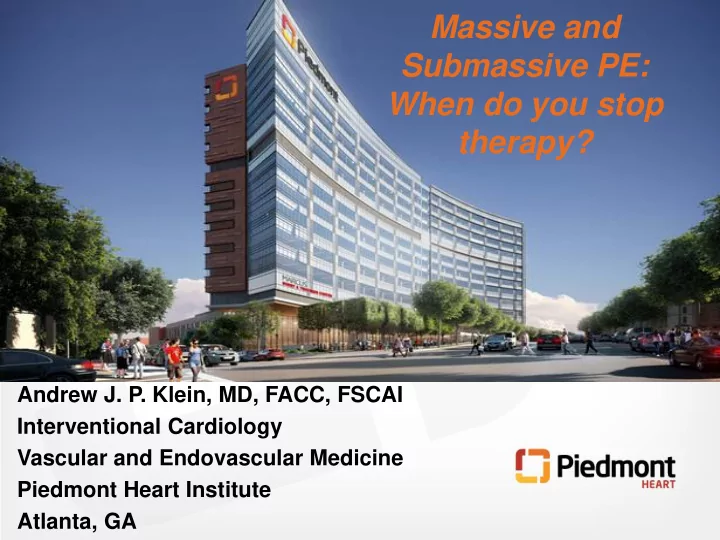

Massive and Submassive PE: When do you stop therapy? Andrew J. P. Klein, MD, FACC, FSCAI Interventional Cardiology Vascular and Endovascular Medicine Piedmont Heart Institute Atlanta, GA
Disclosures: ▪ I have nothing to disclose.
Conflict of Interest • None • Not a talk about what therapy is best
Therapy Endpoints • What are we trying to prevent? • Death • CTED • CTEPH • Post-PE syndrome – Limited functional capacity • When do you stop? – Surgery → Obvious – Lytics → Obvious – Catheter-directed therapy → ???
Endpoint of Therapy How did your patient present? 1. Hypotension – Remember its relative 2. Hypoxemia 3. RV dysfunction 4. Tachycardia Should we follow symptoms? Should we follow biomarkers? Should we repeat the CTA? Follow the PA pressures? Serial Echos? Telemetry? Eyeball test?
PE Categories • Massive: – Acute PE with sustained hypotension (systolic blood pressure 90 mm Hg for at least 15 minutes or requiring inotropic support, not due to a cause other than PE, such as arrhythmia,hypovolemia, sepsis, or left ventricular [LV] dysfunction) pulselessness , or persistent profound bradycardia (heart rate 40 bpm + shock)
Massive PE • Goals – Stabilize BP – Stabilize hypoxemia • Options +/- ECMO – Surgery → Obvious – Lytics → Obvious,maybe – CDT → ??? • Once patient stabilizes then … ?
Massive PE-Surgery Therapy ends at end of case
Treatment of Massive PE: Lytics • Systemic Thrombolytics – Alteplase, tenecteplase – Ease of Administration – ICH Risk – Usually reserved for massive PE • Done once drug is pushed – Watch and wait
Treatment of Massive PE-CDT • ACP recommends CDT in massive PE: – Contraindications or failed thrombolysis • 1 large CDT study – 594 patients – 86.5% clinical success • Stabilization of hemodynamics, resolution of hypoxia, and survival to hospital discharge • But how much TPA and how long for other endpoints? Kearon C, Akl EA, Ornelas J, et al. Antithrombotic therapy for VTE disease: CHEST guideline and expert panel report. Chest 2016;149(2):315 – 352. Kuo W J Vasc Interv Radiol 2009;20(11):1431 – 1440.
Submassive PE • Acute PE without systemic hypotension (systolic blood pressure 90 mm Hg) but with either RV dysfunction or myocardial necrosis – RV dysfunction : • RV dilation (apical 4-chamber RV diameter divided by • LV diameter 0.9) or RV systolic dysfunction on echocardiography • RV dilation (4-chamber RV diameter divided by LV diameter 0.9) on CT • Elevation of BNP (90 pg/mL) • Elevation of N-terminal pro-BNP (500 pg/mL); or • Electrocardiographic changes (new complete or incomplete right bundle- branch block, anteroseptal ST elevation or depression, or anteroseptal T- wave inversion) – Myocardial necrosis is defined: • Elevation of troponin I (0.4 ng/mL) or • Elevation of troponin T (0.1 ng/mL) Jaff M et al. Circulation. 2011;123:1788-1830.)
Predictor of 30d mortality PESI and sPESI Scores Jiménez D et al. Arch Intern Med 2010;170(15):1383 – 1389.
Unhappy Right Ventricles Marker Risk Increase in Mortality RV/LV ratio >0.9 on CT 2.8-7.4X RV Dysfunction on echo 2.4X Elevated Troponin 4-8X Elevated BNP 6x
Submassive PE: When to stop? • Therapies – Anticoagulation alone → once on meds? – ½ to full dose lytics → obvious maybe – Surgery → obvious – CDT → ??? • What are we treating?
Treatment of Submassive PE- Lytics Therapy Endpoint=Drug pushed
Treatment of PE: Catheter-Directed Therapy • Local Delivery of Lytics • Most often done with Pigtail worldwide • +/-PA angiography • Adjunctive therapies can also be performed simultaneously • Pa pressure • 10-20 mg of rTPA per lung over 12-24hrs J Vasc Interv Radiol 2009;20(11):1431 – 1440.
Treatment of PE- Aspiration
Treatment of PE: Aspiration Thrombectomy
Treatment of PE- Remove it
Treatment of PE: INARI Before After
Treatment of Submassive PE- CDT • PERFECT registry – Global prospective registry of CDT – >100 massive and submassive PE patients – > 80% clinical success rate – No major bleeds – Significant reductions in pulmonary arterial pressure. • Should we follow this? – NO ENDPOINT DEFINED Chest 2015;148(3):667 – 673.
Treatment of PE: CDT Trials ULTIMATE TRIAL • 59 patients w acute main or LL PE + echo RV/LV ratio>1.0 randomized to UFH + USAT regimen of 10-20 mg TPA over 15 hours vs. UFH alone • @90 days repeat echo: Majority of patients had no or mild right ventricular dysfunction EKOS group however had complete recovery (100% versus 93% UFH group, P=0.003) Important clinical correlates (such as exertional dyspnea) were not reported. Seattle II Trial • Prospective, single-arm 150 pts receiving EKOS • THERAPY ENDPOINT: 24 mg of t-PA administered • 25% reduction in RV/LV, 30% decrease in PASP, 30% decrease in clot burden OPTALYSE J Am Coll Cardiol Intv 2015 ;8:1382 – 92 Circulation. 2014;129:479-486.)
Long-Term PE Outcomes • Systemic Lytics – TOPCOAT study • Lytic recipients @3 months – Normal RV function – Exercise capacity – Perception of physical wellness – CTED (?%) vs. CTEPH (2-4%) • CDT • What does and how long 6 mg, 10 mg? 20 mg? • When do you stop?
When do you stop? • Resolution of PE with Resolution of PE with Heparin alone thrombolytics – Negligible after 2 hours - 10% at 2 hours – ~10% after 24 hours - 30% at 24 hours – 40% after 7 days - 45% at 7 days – 50% after 2 to 4 weeks - 50% at 2 to 4 weeks ) but does not alter the extent of residual thrombosis Kearon, C. (2003). Duration of therapy for acute venous thromboembolism. Clinics in Chest Medicine. http://doi.org/10.1016/S0272-5231(02)00076-X.
Conclusion • Therapy ends with – Surgery → Obvious – Lytic → Obvious – CDT • Alive • No bleeding • BP stable • Hypoxia resolved • Heart rate • RV function-echo • CT, maybe but radiation • Eyeball, Symptoms • PERT TEAM DECISION
Thank you!
Recommend
More recommend